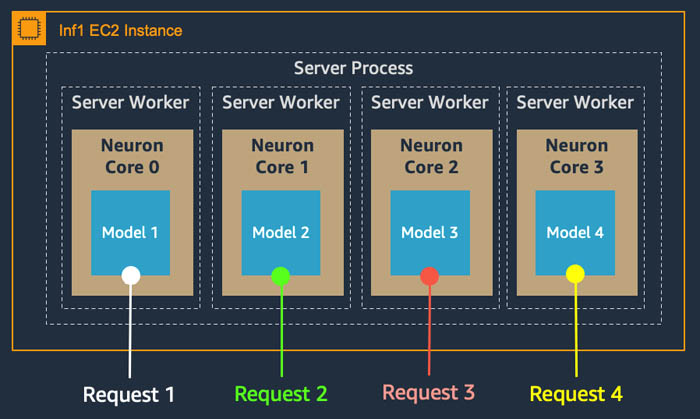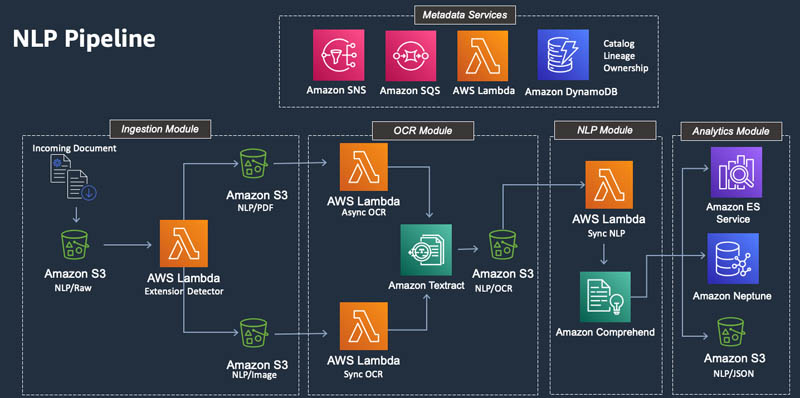AWS Machine Learning Blog
Achieve 12x higher throughput and lowest latency for PyTorch Natural Language Processing applications out-of-the-box on AWS Inferentia
AWS customers like Snap, Alexa, and Autodesk have been using AWS Inferentia to achieve the highest performance and lowest cost on a wide variety of machine learning (ML) deployments. Natural language processing (NLP) models are growing in popularity for real-time and offline batched use cases. Our customers deploy these models in many applications like support […]
Creating an end-to-end application for orchestrating custom deep learning HPO, training, and inference using AWS Step Functions
Amazon SageMaker hyperparameter tuning provides a built-in solution for scalable training and hyperparameter optimization (HPO). However, for some applications (such as those with a preference of different HPO libraries or customized HPO features), we need custom machine learning (ML) solutions that allow retraining and HPO. This post offers a step-by-step guide to build a custom deep […]
Introducing hierarchical deletion to easily clean up unused resources in Amazon Forecast
Amazon Forecast just launched the ability to hierarchically delete resources at a parent level without having to locate the child resources. You can stay focused on building value-adding forecasting systems and not worry about trying to manage individual resources that are created in your workflow. Forecast uses machine learning (ML) to generate more accurate demand […]
Translate All: Automating multiple file type batch translation with AWS CloudFormation
This is a guest post by Cyrus Wong, an AWS Machine Learning Hero. You can learn more about and connect with AWS Machine Learning Heroes at the community page. On July 29, 2020, AWS announced that Amazon Translate now supports Microsoft Office documents, including .docx, .xlsx, and .pptx. The world is full of bilingual countries […]
Scale session-aware real-time product recommendations on Shopify with Amazon Personalize and Amazon EventBridge
January 2022 – HiConversion is now Obviyo. We have updated this blog to reflect the new company name. You can read more about the name change on Obviyo’s blog. This is a guest post by Jeff McKelvey, Principal Development Lead at Obviyo. The team at Obviyo has collaborated closely with James Jory, Applied AI Services […]
Annotate dense point cloud data using Amazon SageMaker Ground Truth
Autonomous vehicle companies typically use LiDAR sensors to generate a 3D understanding of the environment around their vehicles. For example, they mount a LiDAR sensor on their vehicles to continuously capture point-in-time snapshots of the surrounding 3D environment. The LiDAR sensor output is a sequence of 3D point cloud frames (the typical capture rate is […]
Intelligent governance of document processing pipelines for regulated industries
Processing large documents like PDFs and static images is a cornerstone of today’s highly regulated industries. From healthcare information like doctor-patient visits and bills of health, to financial documents like loan applications, tax filings, research reports, and regulatory filings, these documents are integral to how these industries conduct business. The mechanisms by which these documents […]
Announcing the AWS DeepComposer Chartbusters challenges 2021 season launch
We’re back with two new challenges for the AWS DeepComposer Chartbusters 2021 season! Chartbusters is a global challenge in which developers use AWS DeepComposer to create original compositions and compete in monthly challenges to showcase their machine learning (ML) and generative artificial intelligence (AI) skills. Regardless of your background in music or ML, one of […]
AWS DeepRacer device software now open source
AWS DeepRacer is the fastest way to get started with machine learning (ML). You can train reinforcement learning (RL) models by using a 1/18th scale autonomous vehicle in a cloud-based virtual simulator and compete for prizes and glory in the global AWS DeepRacer League. Today, we’re expanding AWS DeepRacer’s ability to provide fun, hands-on learning […]
Monitor and Manage Anomaly Detection Models on a fleet of Wind Turbines with Amazon SageMaker Edge Manager
September 8, 2021: Amazon Elasticsearch Service has been renamed to Amazon OpenSearch Service. See details. In industrial IoT, running machine learning (ML) models on edge devices is necessary for many use cases, such as predictive maintenance, quality improvement, real-time monitoring, process optimization, and security. The energy industry, for instance, invests heavily in ML to automate […]







